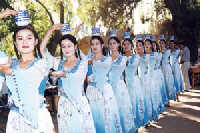 The music of other ethnic groups is no match for the gigantic and neatly arranged system of the "Twelve Muqam."
The music of other ethnic groups is no match for the gigantic and neatly arranged system of the "Twelve Muqam."
Strictly following the astronomical almanac, each of the "Twelve Muqam" is divided into three parts: Cong Naghma, Dastan and Mashrap, each with 25-30 sub-melodies.
The whole set of the "Twelve Muqam" consists of 360 different melodies and takes over 20 hours to play in full.
While Muqam is a musical form that has spread in Islamic areas throughout the world, the "Twelve Muqam" carries distinct Uygur characteristics.
What is significant about its compilation is that Amannisahan did not borrow material from the wealthy and fully developed Arabian and Persian repertoires. Instead, she exploited the rich resources of Uygur folk music spread out in the wide area in the north and south of the Tianshan Mountains. As a result, the "Twelve Muqam" is especially distinct due to its strong Uygur flavor.
Since its spread among the Uygurs, the "Twelve Muqam" has played an inseparable role in the people's lives. They dance to the accompaniment of "Twelve Muqam" and sing songs and ballads to its melodies.
After the founding of new China (1949), the local government of the Xinjiang Uygur Autonomous Region made every effort possible to preserve the "Twelve Muqam."
In 1956, Muqam master Turdi Ahun and musician Wan Tongshu, working with other assistants, took great pains to record most of the vocal melodies and librettos of the "Twelve Muqam" on tape. They also recorded the music by hand.
